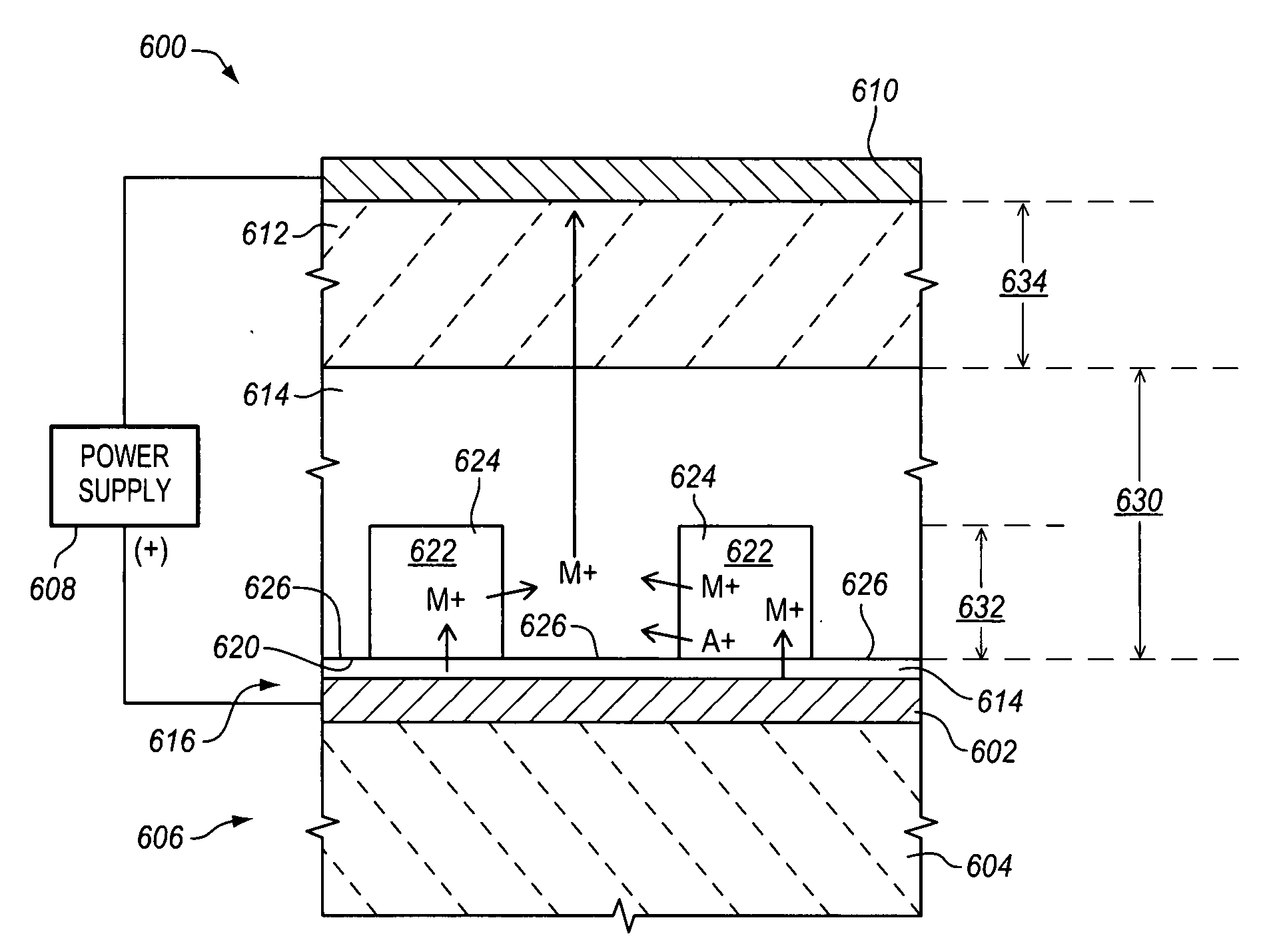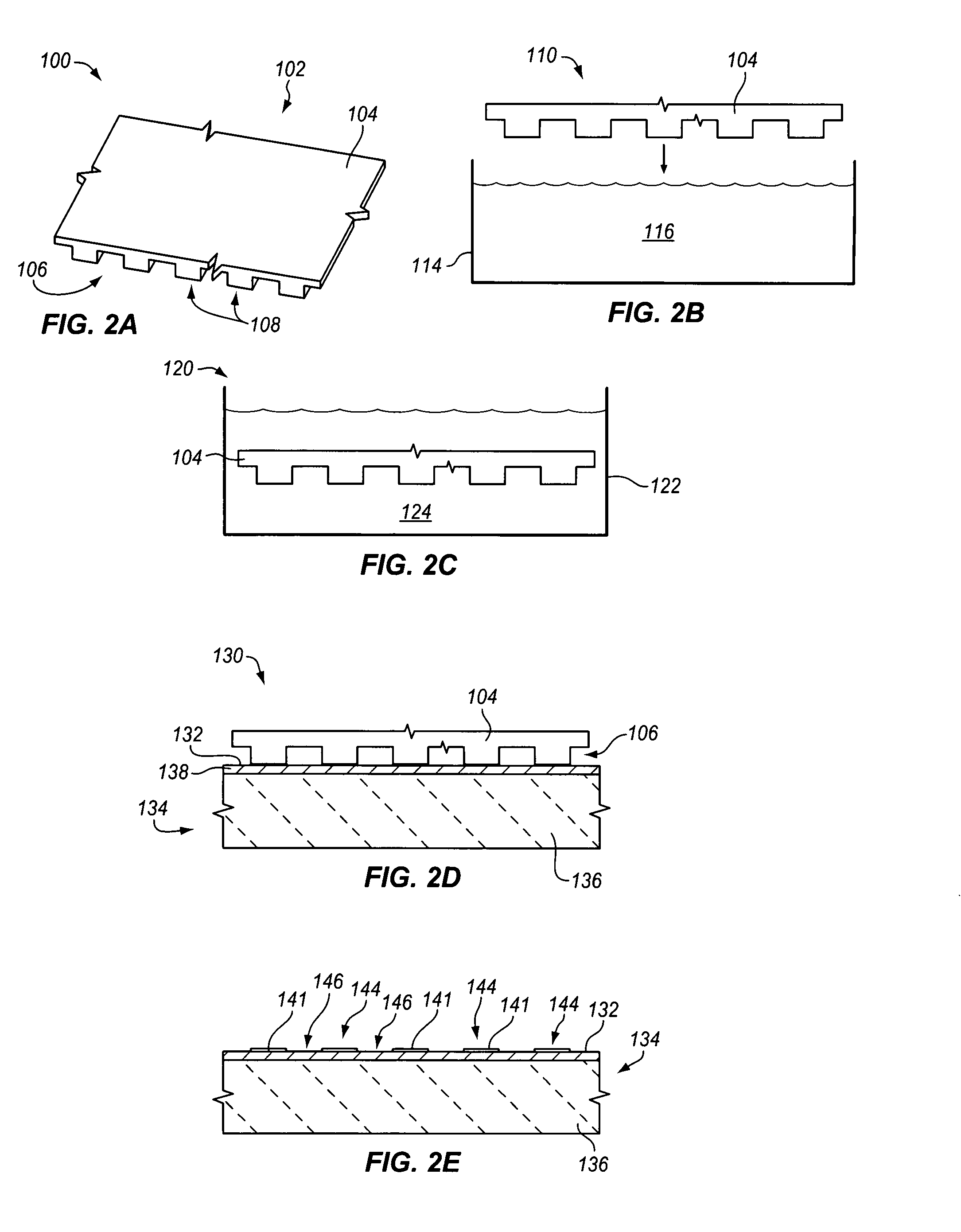Photoresist-free metal deposition
a metal deposition and resist-free technology, applied in the field of photoresist-free metal deposition, can solve the problems of requiring extra effort associated with removing overburden material, reducing or eliminating the associated material and equipment expenses, environmental costs, and processing tim
- Summary
- Abstract
- Description
- Claims
- Application Information
AI Technical Summary
Benefits of technology
Problems solved by technology
Method used
Image
Examples
example 1
[0159]An exemplary embodiment of a method of forming a stamp in accordance with the invention suitable for selectively applying a substrate-treating species to a substrate surface is described herein with reference to FIGS. 6B-6E. It is understood that other embodiments in accordance with the invention are suitable for making a stamp.
[0160]A circular piece of blank (unpatterned) nanoporous material having a diameter of about 400 mm is fastened to a flat, circular polymeric support having a diameter of about 330 mm. The nanoporous membrane material is attached to the support by a circular ring that slides down around the outside edge of the circular support. One example of a suitable nanoporous membrane material is NAFION®, commercially available from Dupont. Another is resorcinol formaldehyde aerogel, as described in U.S. Pat. No. 4,873,218, issued Oct. 10, 1989, to Pekala, and in U.S. Pat. No. 4,997,804, issued Mar. 5, 1991, to Pekala, which are hereby incorporated by reference as ...
example 2
[0162]A 300 mm semiconductor wafer is located face-up on a substrate holder. The wafer comprises a flat base dielectric SiO2 layer covered by a smooth 40 nm copper seed layer. A patterned membrane stamp as described in Example 1 is attached by a circular clamp to a face-down stamping head having a diameter of 330 mm. The material composition of the stamping head is essentially porous polyvinylidene difluoride (PVDF). The stamping head contains an integral liquid reservoir having a total volume of about 200 ml containing 1 g / L MPSA in water accelerator solution. The stamping head is lowered so that the membrane make physical contact with the substrate with a pressure of approximately 1 psi for approximately 2 minutes to form an accelerated pattern region containing accelerator on the substrate (e.g., FIG. 2E).
[0163]Thereafter, the substrate surface is electrochemically plated in a copper plating apparatus for 60 seconds at 15 mA / cm2 in a bath containing 50 ppm dimercaptopropane sulph...
example 3
[0164]A 300 mm semiconductor wafer is located face-up on a substrate holder. The wafer comprises a base dielectric SiO2 layer covered by a 20 mm copper seed layer. A patterned membrane stamp as described in Example 1 is attached by a circular clamp to a face-down stamping head having a diameter of 330 mm, as described in Example 2. The stamping head contains an integral liquid reservoir having a total volume of about 600 ml containing 1 g / L 3-mercapto-1-butanol in water accelerator precursor solution. The stamping head is lowered so that the membrane make physical contact with the substrate with a pressure of approximately 1 psi for approximately 2 minutes to form a treated pattern region containing accelerator precursor on the substrate (e.g., FIG. 2H).
[0165]The accelerator precursor is converted to an active accelerator by converting the alcohol group to a sulfonic acid. This acidification is effected by exposing the substrate surface to 10% sulfuric acid at room temperature for a...
PUM
| Property | Measurement | Unit |
|---|---|---|
| feature widths | aaaaa | aaaaa |
| contact time | aaaaa | aaaaa |
| wavelength | aaaaa | aaaaa |
Abstract
Description
Claims
Application Information
 Login to View More
Login to View More - R&D
- Intellectual Property
- Life Sciences
- Materials
- Tech Scout
- Unparalleled Data Quality
- Higher Quality Content
- 60% Fewer Hallucinations
Browse by: Latest US Patents, China's latest patents, Technical Efficacy Thesaurus, Application Domain, Technology Topic, Popular Technical Reports.
© 2025 PatSnap. All rights reserved.Legal|Privacy policy|Modern Slavery Act Transparency Statement|Sitemap|About US| Contact US: help@patsnap.com



